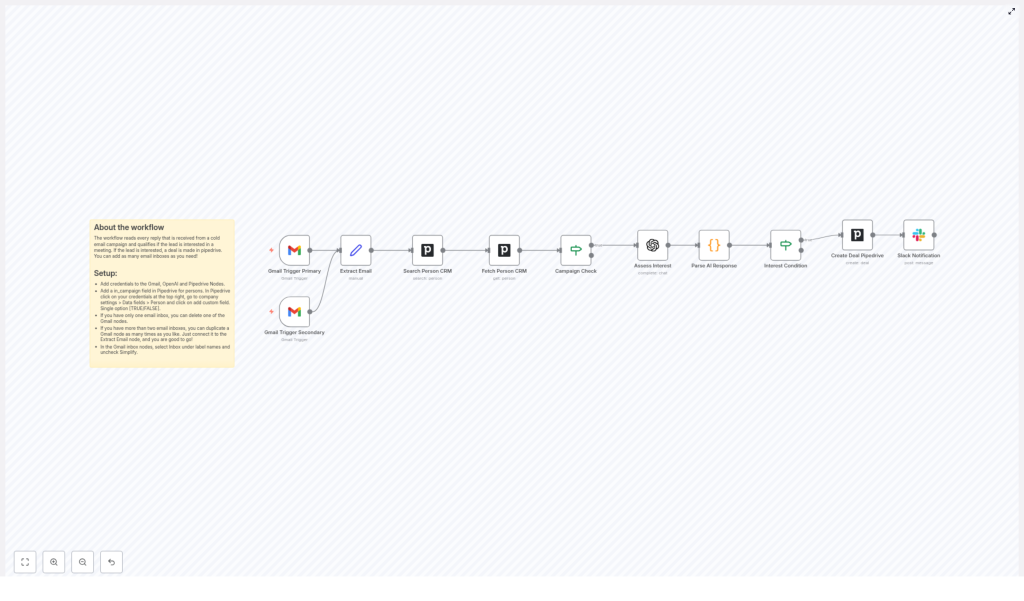Automate Cold Email Reply Qualification with n8n
Managing replies to cold email campaigns is time-consuming. This n8n workflow automatically reads replies from Gmail, checks your Pipedrive CRM, uses OpenAI to assess interest, and creates deals for qualified leads — saving SDRs hours every week.
Why automate cold email reply qualification?
Manual triage of inbound replies is slow, error-prone, and expensive. Automating reply qualification lets your sales team focus on high-value conversations instead of reading and categorizing dozens of follow-ups. This workflow combines Gmail, Pipedrive and OpenAI for fast, reliable qualification and automatic deal creation.
Workflow overview
The workflow in this guide uses the following components:
- Gmail triggers (primary and secondary) — watch inboxes for replies
- Extract Email (Set node) — normalize incoming message text
- Pipedrive Search & Fetch — find the person and pull custom fields
- Campaign Check (If node) — only process people attached to your campaign
- OpenAI (Assess Interest) — evaluate whether the reply indicates interest
- Parse AI Response (Code node) — extract structured JSON from the AI
- Interest Condition (If node) — if interested == yes, create Pipedrive Deal
- Slack Notification — alert the sales channel when a deal is created
Step-by-step node breakdown
1. Gmail Trigger (Primary / Secondary)
Use one or more Gmail Trigger nodes to monitor inboxes. Set the node to poll frequently (for example, every minute) but be mindful of API quotas. In the node settings uncheck “Simplify” and select the Inbox label to ensure you receive the full message context.
2. Extract Email (Set node)
The Set node standardizes the incoming message text into a named field (for example, email or text) so downstream nodes can reference it easily. This helps avoid breaking changes when Gmail payloads vary.
3. Search Person CRM & Fetch Person CRM (Pipedrive)
Search Person CRM looks up the sender’s email in Pipedrive to find an existing person. If found, Fetch Person CRM retrieves full person details, including any custom fields you use to mark campaign membership or qualification status.
4. Campaign Check (If node)
Many teams add a boolean person field in Pipedrive like in_campaign to indicate active campaign targets. The If node ensures you only process replies that came from your outbound campaign, avoiding noise from unrelated contacts.
5. Assess Interest (OpenAI)
This node sends the email reply text to OpenAI with a prompt designed to return a compact JSON object indicating whether the lead is interested and why. Keep the prompt explicit and give the model a JSON format to reduce parsing errors.
6. Parse AI Response (Code node)
Use a small JavaScript code node to parse the AI response into discrete fields (for example, interested and reason). The workflow example expects the AI to return {"interested":"yes"|"no","reason":"..."}.
7. Interest Condition & Deal Creation
The If node checks the parsed interested value. If it’s yes, Create Deal Pipedrive builds a new deal with a useful title and optional custom fields. You can automatically set stage, owner, or priority depending on your sales process.
8. Slack Notification
Optionally notify your sales channel when a deal is created so an SDR can follow up immediately. This keeps your team aligned and speeds up response time.
Setup checklist
- Create credentials in n8n for Gmail, Pipedrive and OpenAI.
- In Pipedrive, add a person custom field named in_campaign (single option TRUE/FALSE).
- Configure Gmail nodes to monitor Inbox, uncheck Simplify, and pick appropriate polling intervals.
- Test the OpenAI prompt with sample replies until it consistently returns valid JSON.
- Adjust Pipedrive deal creation fields (title, owner, stage) to match your pipeline.
Improving the OpenAI prompt
A robust prompt reduces parsing errors and enhances accuracy. Example improvements:
- Be explicit about the expected JSON output.
- Provide examples of positive, neutral, and negative replies.
- Limit the model to a short answer to reduce hallucination.
Example prompt snippet to include in the Assess Interest node:
Analyze the following email reply and return only JSON:
{"interested":"yes" or "no","reason":"one-sentence justification"}
Reply:
"{{email_text}}"
Testing & debugging tips
- Use a test inbox and sample replies to validate each node before going live.
- Enable execution logs in n8n and inspect intermediate outputs (especially the OpenAI response) to catch formatting issues.
- If the AI occasionally returns malformed JSON, add a small sanitizer in the Code node to fix trailing text or whitespace.
Security, privacy & compliance
Automating email replies with AI means you may send personal data to third-party APIs. Consider the following:
- Review OpenAI’s data usage and opt out of data logging if required for your compliance
- Mask or redact sensitive personal data before sending it to the model when possible
- Store only the minimum necessary data in Pipedrive and purge test data regularly
Customization ideas
- Score interest on a scale (0–100) instead of a binary yes/no and route high-score replies automatically.
- Automatically schedule a meeting when the reply contains a time suggestion using a calendar API integration.
- Send a follow-up email for “maybe” replies using personalized templates.
Common issues & fixes
AI returns invalid JSON
Add a trimming and validation step in the Parse AI Response node. Provide clear examples in the OpenAI prompt.
Pipedrive person not found
Confirm the Search Person CRM node uses the correct email field and that incoming replies contain the original outbound email. Consider fuzzy matching on name or company when emails differ.
Conclusion & next steps
This n8n cold email reply qualifier reduces manual triage, shortens response times, and increases your SDRs’ capacity to handle high-value leads. Start with a conservative configuration, test thoroughly, and iterate on the OpenAI prompt and deal creation rules to match your sales process.
Ready to automate your reply qualification? Import the workflow into n8n, connect your Gmail, Pipedrive and OpenAI credentials, and run a controlled test. If you want help customizing the flow for your sales process, reach out to your automation specialist or consult the n8n community.

